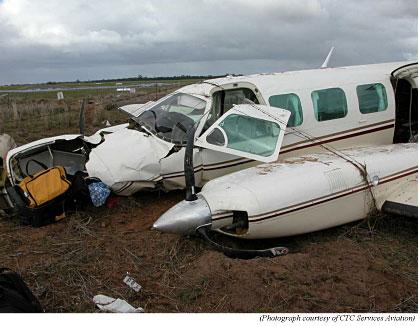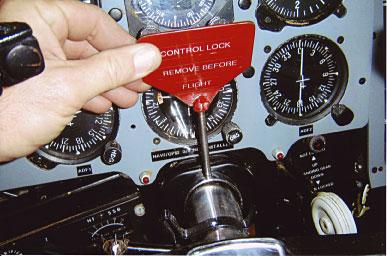Sequence of events
On 25 July 2005, at about 1835 Eastern Standard Time, a Piper Aircraft Corporation PA-31-350 (Chieftain) aircraft, registered VH-PRJ, overran runway 27 at Nhill aerodrome following a rejected night take-off. The aircraft was being operated on an instrument flight rules charter flight to Charlton, Vic, with the pilot and three passengers on board. The pilot and passengers sustained injuries during the overrun and the aircraft was substantially damaged (Figure 1).
Figure 1: Wreckage of aircraft with runway in the background
Earlier that day, the pilot had flown the aircraft from Essendon to Ouyen and then to Nhill, arriving at about 1500. During the stopover at Nhill, the pilot secured the flight controls by inserting a lock pin in the control column.
The pilot stated that, when he started and warmed the engines at about 1700, he removed the lock from the control column and that it was reinserted after the engines were shut down. The passengers arrived at the aerodrome at about 1820 and boarded soon afterwards.
The pilot reported that, during the pre-flight preparation at Nhill, he set the elevator trim to the take-off position by winding the trim wheel to about three rotations back from the full nose-down position. The pilot recalled removing the lock from the control column prior to starting the engines for departure.
The pilot stated that he usually checked the flight controls for full and free movement while backtracking on a runway but he could not recall whether he performed that check when backtracking on runway 27 at Nhill. Part B of the operator's Operations Manual included a series of checklists to be used during operation of the aircraft. The 'Start Up' and 'Pre takeoff' checklists included checking full and free movement of the flight controls.
A witness, located in a house adjacent to the western perimeter of the aerodrome, reported that he observed the aircraft taxi to the eastern end of the runway and commence the take-off roll but lost sight of the aircraft as it moved along the runway.
The pilot stated that the take-off roll was from a rolling start with power being slowly applied until engine turbo-charger output stabilised. At about 90 kts indicated air speed, the pilot attempted to rotate the aircraft but encountered resistance to rearward movement of the control column. He decided to reject the takeoff because the aircraft speed at the time was below his nominated decision speed of 100 kts. The pilot reported that he then reduced the engine power to idle and applied maximum braking.
The aircraft overran the runway, passed through the airport boundary fence, continued across a public road, and passed through another fence before coming to a stop in a paddock about 162 m beyond the end of the runway. An inspection of the runway revealed a skid mark from the aircraft's right tyre, which commenced 65 m before the end of the runway.
After the aircraft came to a stop, the pilot exited the aircraft via the crew door, assisted the passengers to evacuate the aircraft through the rear cabin door and marshalled them to an area away from the aircraft. A passenger then used a mobile phone to contact emergency services, who attended the scene soon after.
The aircraft
A subsequent inspection of the aircraft revealed that there were no pre-existing defects in the elevator control system and elevator trim system or evidence of interference with the elevator surfaces. The elevator trim setting was found to be three and a half rotations of the trim wheel from the full nose-down position.
Between flights, the aircraft elevators and ailerons were locked with a removable control lock (Figure 2). The lock was a 10 cm long pin with a red plastic warning tag which was inserted through the control column and a locking collar that was attached to the instrument panel. There were no external control locks fitted.
The Australian Transport Safety Bureau was advised that the control lock was found in a cockpit stowage pocket after the accident. An inspection of the lock shaft did not reveal any witness marks or deformation caused by the lock being left in the locking collar during the impact sequence.
Figure 2: View of control lock partially removed from control column
The aircraft was fitted with a Bendix Altimatic V FD-1 autopilot system. The autopilot controller panel was located on the centre cockpit pedestal behind the engine controls. Engagement of the autopilot system was accomplished by pressing the AP ENGAGE BUTTON, located on the left side of the controller panel. The button would illuminate when the autopilot was engaged.
The pilot could not recall whether any buttons were illuminated on the autopilot controller prior to, or during, the take-off roll. The system was designed to allow a pilot to momentarily override an autopilot input to the flight controls.
The main landing gear wheel brakes were serviceable and did not exhibit any indications of overheating.
Aircraft performance
The take-off weight and centre of gravity of the aircraft were within limits for the flight.
The approved Aircraft Flight Manual (AFM) contained take-off distance and accelerate-stop distance performance charts for both normal and short field takeoffs. The investigation calculated the take-off performance of the aircraft using the following aerodrome and meteorological information:
- runway length 1,000 m with a bitumen surface
- runway slope 0.8 per cent down to the west
- wind 300 degrees true, 10 kts gusting to 13 kts
- no rainfall recorded during the previous three hours.
The normal take-off distance chart indicated that with take-off power being set before brakes release, the prevailing weather conditions and a take-off weight estimated by the investigation to be 2,941 kg, the aircraft would have a take-off distance of about 644 m from brakes release to 50 ft. With application of the 1.24 factor specified in Civil Aviation Order 20.7.4 for charter operations, the take-off distance required was 799 m, which was within the length of runway 27.
The normal accelerate-stop distance charts were based on take-off power being set before brakes release, wing flaps retracted, a paved, level and dry runway surface, and an 'abort' (reject) speed of 88 kts indicated air speed. The chart allowed for a failure recognition time of 3 seconds. If the pilot technique in applying take-off power differed from that stated on the accelerate-stop chart, the distance to perform the accelerate-stop manoeuvre would be more than the chart derived figure. Provided the takeoff was rejected at 88 kts, the chart indicated that, under the conditions prevailing at the time of the accident, the accelerate-stop distance was about 845 m, which was within the length of runway 27.
The aircraft manufacturer's procedure for a rejected takeoff was included in the emergency procedure for an engine failure during a normal takeoff at or below 85 kts. That procedure specified that the engine throttles were to be immediately closed and brakes applied as required to stop straight ahead.




